Lily Palmer beamed with contented joy as she took part in a Corpus Christi procession at San Pedro Parish in North Port on June 11, 2023, the Solemnity of the Most Holy Body and Blood of Christ.

“The power of Our Lord, and His Presence in the Blessed Sacrament, brings me great comfort,” Palmer said. “I feel so happy to be able to honor Jesus in this special way.”
The Solemnity of the Most Holy Body and Blood of Christ (Corpus Christi) is a celebration of the Eucharist and the Real Presence of Our Lord which is a tradition that dates back centuries and is often marked by a Eucharistic Procession, a “public witness of faith and worship of the Most Blessed Sacrament.”

Prior to the solemnity, San Pedro Parish hosted a 40-Hours of Devotion (Eucharistic Adoration), as part of the ongoing celebration of the National Eucharistic Revival. The 40 Hours was opened on the afternoon of June 9 by Parochial Vicar Father Nathan Marzonie, Oblate of the Virgin Mary, as a large group participated. Parishioners filled in the hours through the day and night (with the exception of times for the celebration of Mass) to stand vigil with the Blessed Sacrament.
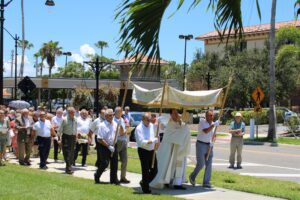
At the Mass on the Solemnity, Father Marzonie explained that Corpus Christi is a day to celebrate the gift of the Most Holy Eucharist, “not because it’s only worth celebrating that gift, or paying honor to honor Jesus in a special way once a year, but to help us grow in that for every day. To remind us that Jesus gave us this gift, to give His presence to us, to be always with us. Every day. All the time.”
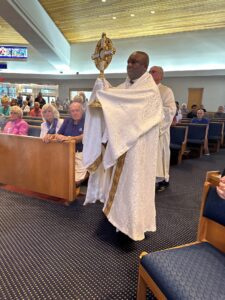 After the celebration of the 10:45 a.m. Mass at San Pedro, the Corpus Christi procession began with the placement of a consecrated host in the monstrance (a sacred vessel that displays the sacred host to the faithful). After a brief time for all to pray before the Most Holy Eucharist, the procession, led by altar servers carrying candles and an incenser, began. Father Marzione carried the monstrance with the Blessed Sacrament. Proceeding out of the church, the faithful followed; members of the Knights of Columbus escorted the Blessed Sacrament by carrying the canopy.
After the celebration of the 10:45 a.m. Mass at San Pedro, the Corpus Christi procession began with the placement of a consecrated host in the monstrance (a sacred vessel that displays the sacred host to the faithful). After a brief time for all to pray before the Most Holy Eucharist, the procession, led by altar servers carrying candles and an incenser, began. Father Marzione carried the monstrance with the Blessed Sacrament. Proceeding out of the church, the faithful followed; members of the Knights of Columbus escorted the Blessed Sacrament by carrying the canopy.
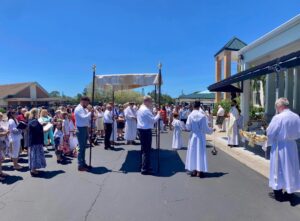 The canopy serves a dual purpose. On one hand, it protects the Blessed Sacrament against anything that might fall on it, including light rain, creating a “sacred space” that is reserved for the priest carrying the monstrance. Secondarily, the faithful in the large crowd can locate the Blessed Sacrament at the head of the procession more easily.
The canopy serves a dual purpose. On one hand, it protects the Blessed Sacrament against anything that might fall on it, including light rain, creating a “sacred space” that is reserved for the priest carrying the monstrance. Secondarily, the faithful in the large crowd can locate the Blessed Sacrament at the head of the procession more easily.
As the procession circled the church, the faithful sang. At three locations along the route there were decorated altars where the monstrance was placed and, after a period of prayer (which included a Gospel reading and intercessions), the people were blessed. In this way the Church shows that Christ, here among us, walks with us on our pilgrimage to heaven. A Eucharistic Procession is not only a tradition in the Catholic Church but is a public witness of our faith in the Blessed Sacrament in the community.
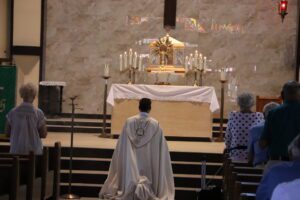
Launched as an initiative of the U.S. Catholic Bishops in June 2022, the National Eucharistic Revival is a three-year movement by the U.S. Bishops to answer the call of Jesus Christ to return to the source and summit of Our Faith – the Real Presence in the Holy Eucharist. This effort includes a National Eucharistic Congress next year in Indianapolis. The Revival’s first year was titled “The Year of Diocesan Revival,” and efforts focused on formation for Diocesan leadership and Diocesan-wide events (March 2023 Diocesan Eucharistic Congress and Youth Rally). The Revival’s second year, “The Year of Parish Revival,” aims to reach Catholics in their Parishes through renewed attention to the “art” of the Mass, Eucharistic devotions, and small-group faith sharing and formation.
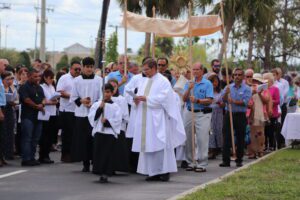
Instituted in 1264 by Pope Urban IV, Corpus Christi is an important affirmation of our belief that Our Lord is really and truly sacramentally present in the form of bread and wine. When Our Lord instituted the Eucharist, He said this IS My Body and this IS My Blood; not this represents or is symbolic of my body and blood. The Sacrament was defined as “an outward sign” of inward grace given to us by Jesus Christ for our sanctification and salvation.
The Feast of Corpus Christi is observed two weeks after Pentecost. The Feast of Pentecost, which was on May 28 this year, is celebrated 50 days after Easter Sunday, and commemorates the descent of the Holy Spirit upon the Apostles and other followers of Jesus Christ while they were in Jerusalem, as described in the Acts of the Apostles.
